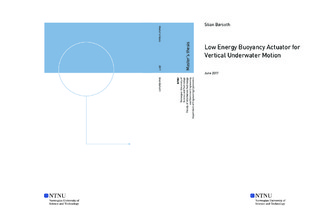| dc.description.abstract | This thesis presents the physical and technical premise for implementing and designing an
underwater vehicle capable of moving vertically using the unit s own buoyancy force, and
how this principle benefit in energy efficiency. The goal is to create a prototype unit that
makes experimental testing and documentation of this principle possible.
An electrical linear actuator with a piston was used to manipulate the unit s volume. Depth
control was achieved using a PID controller combined with a pressure sensor, and the control
parameters tuned by implementing simulations of the unit s dynamical behavior. By
combining two power saving methods, it was estimated (using simulations) to reduce the
power consumption to 12.6% of maximum power consumption. A 3D model of the unit
was made to determine the vertical stability, mass properties, and to create drawings of a
prototype.
A functional prototype was successfully implemented, and two physical experiments were
carried out. The physical experiments were not sufficient to determine the unit s energy
efficiency using buoyancy as a principle of vertical movement underwater. But the work
here suggest there is a promising potential for the unit being energy efficient. | |

